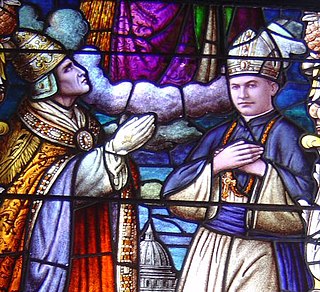
The archbishop of Uppsala has been the primate in Sweden in an unbroken succession since 1164, first during the Catholic era, and from the 1530s and onward under the Lutheran church.

The Diocese of Skara is the oldest existing diocese in Sweden, originally a Latin bishopric of the Roman Catholic church, and since Protestant reformation a Lutheran diocese of the Church of Sweden, with its seat at Skara in Västergötland. In 2014, it celebrated its 1000-year anniversary as a full diocese.

The Diocese of Tampere is the second oldest and the largest diocese in the Evangelical Lutheran Church of Finland. It is divided into 69 parishes with a total population of over 595,000 people. The diocese is led by the Bishop of Tampere.
The table of years in art is a tabular display of all years in art, for overview and quick navigation to any year.
The table of years in architecture is a tabular display of all years in architecture, for overview and quick navigation to any year.

Theatrum Chemicum is a compendium of early alchemical writings published in six volumes over the course of six decades. The first three volumes were published in 1602, while the final sixth volume was published in its entirety in 1661. Theatrum Chemicum remains the most comprehensive collective work on the subject of alchemy ever published in the Western world.
The High Sheriff of Nottinghamshire, Derbyshire and the Royal Forests is a position established by the Normans in England.

Smålands nation is one of the thirteen student nations at Uppsala university in Sweden. It has around 1500 members, many of them international students. Smålands nation is well known for its live music scene and for its generous scholarships.

Ås Abbey was a Cistercian monastery situated near the mouth of the River Viskan into the Kattegat in Halland, formerly part of Denmark but now in Sweden, near the present hamlet of Åskloster about 14 km north of Varberg, in Varberg Municipality.
Sámi schools, which were referred to as Nomad schools or Lapp schools before 1977, are a type of school in Sweden that runs parallel to the standard primary school system. Sámi schools are part of the Swedish public school system, and as such are governed by the same curriculum that primary schools are. Sámi schools are state-owned educational institutions that are open to all children whose parents claim to be Sámi. Each school has its own dormitory that many students live in for large parts of the academic year due to the long distances in the north of Sweden.
The Mayor of Bratislava is the highest political representative of the Slovak capital Bratislava. The Mayor's office is located at Primate's Square inside Primate's Palace, on the 3rd floor. Current Mayor of Bratislava is Matúš Vallo, since 2018.
The bailo of Negroponte was the representative of the Republic of Venice stationed at Chalcis (Negroponte) on the island of Euboea. The bailo played an important role as the mediator between, and de facto overlord of, the triarchs of Euboea, who had their common residence in Negroponte. The triarchies were created by the division of the island between three rulers (triarchs) after its conquest following the Fourth Crusade (1204).
The Liturgical Struggle was the name for the period from 1574 until 1593 in Sweden, when there was a struggle about the confession of faith and liturgy of the Church of Sweden, brought about by the attempts of King John III of Sweden to make the Swedish church take a mediating position between Catholicism and Protestantism by holding only certain doctrines and practices which could be established immediately in either the Word of God or patristic writings, similar to what had once been imposed on the Lutheran areas in Germany during the Augsburg Interim. The struggle began in 1574, when the king introduced some new rules in the liturgy which were not in accordance with Lutheran doctrine and practice, followed by his publication of the Liturgia Svecanæ Ecclesiæ catholicæ & orthodoxæ conformia commonly called the "Red Book", which re-introduced a number of Catholic customs. The Liturgical Struggle ended with the Lutheran confession of faith at the Uppsala Synod in 1593.

Abraham Danielsson Hülphers (1704-1770), also known as Abraham Hülphers the Older, was a Swedish early industrialist, and politician.











